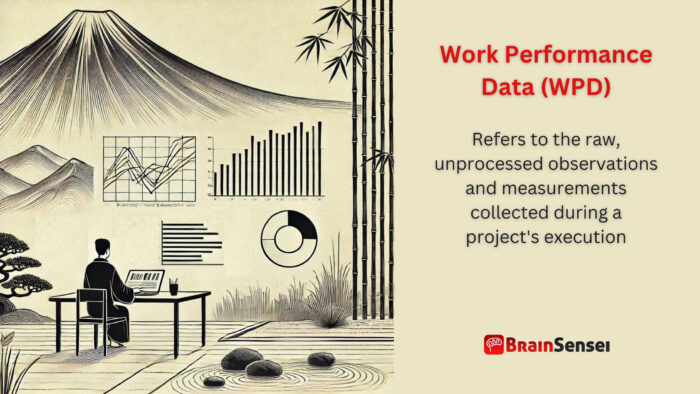
Work Performance Data
What is Work Performance Data?
Work performance data (WPD) refers to the raw, unprocessed observations and measurements collected during a project’s execution. This data includes cost, schedule, scope, quality, and resource utilization metrics. It is the foundation for analyzing project progress and performance before being transformed into actionable insights.
Key Takeaways
- Raw Data Source: WPD consists of unprocessed numbers, figures, and observations gathered during project execution.
- Basis for Decision-Making: It feeds into performance reports and forecasts to guide project managers.
- Project Performance Indicators: Includes schedule adherence, budget tracking, quality metrics, and risk status.
- Leads to Work Performance Information (WPI): When analyzed, WPD transforms into meaningful insights for decision-making.
- Essential for Project Control: Helps identify deviations from plans and supports corrective actions.
Understanding Work Performance Data
How It Works
Project teams collect Work Performance Data from various project activities in real time and use it to assess project health. It includes:
- Schedule Data: Task completion percentages, milestones achieved, and delays.
- Cost Data: Budget spent, cost variances, and earned value metrics.
- Quality Metrics: Defect rates, compliance percentages, and inspection results.
- Resource Utilization: Hours worked, labor productivity, and material consumption.
Project teams use this data to generate Work Performance Information (WPI) and refine it into Work Performance Reports (WPRs) for stakeholders.
Notes
- Raw vs. Processed Data: WPD is unprocessed and may require contextual analysis.
- Collected Continuously: Data is gathered throughout the project lifecycle.
- Accuracy Matters: Inaccurate data can lead to misleading insights and poor decisions.
- Supports Forecasting: Historical data trends can predict future project performance.
Related Terms
- Work Performance Information (WPI): Analyzed WPD that provides meaningful insights into project performance.
- Work Performance Reports (WPRs): Formal reports presenting WPI to stakeholders for decision-making.
- Earned Value Management (EVM): A WPD technique to measure project performance based on scope, cost, and schedule.
- Key Performance Indicators (KPIs): Metrics derived from WPD to assess project success.
- Project Management Information System (PMIS): Software used to collect, process, and report WPD.
Examples of Work Performance Data in Different Industries
Construction Industry
Meticulous progress tracking is required when building a large-scale project like a highway. Work Performance Data includes the hours logged, materials delivered and used, weather conditions affecting site work, safety incidents, and daily productivity levels. For example, a road construction project might track daily asphalt pouring, concrete curing times, and the number of workers on-site.
Real-time WPD monitors equipment utilization, subcontractor performance, and environmental compliance. If raw data shows a significant lag in material delivery, project managers can adjust schedules or find alternative suppliers to prevent downtime. Additionally, quality inspections generate WPD, such as measurements of pavement thickness or concrete compression strength, ensuring the project meets engineering standards.
IT & Software Development
In an agile software development environment, WPD includes sprint velocity, the number of completed user stories, bug resolution rates, and the number of lines of code written. A project manager overseeing a software development cycle will analyze data on how long tasks take to complete compared to estimates.
For example, if the velocity of completed story points per sprint drops unexpectedly, WPD helps pinpoint the cause. The team might identify issues such as excessive technical debt, inadequate developer resources, or unclear requirements. This data-driven insight allows adjustments to sprint planning, such as reallocating developers or refining backlog priorities.
Additionally, software developers can collect WPD from automated testing tools, error logs, and deployment success rates. A high failure rate in nightly builds might indicate integration problems, prompting developers to revise their approach before it escalates.
Healthcare & Pharmaceuticals
Hospitals and pharmaceutical companies rely on WPD to ensure operational efficiency and regulatory compliance. For example, WPD tracks construction milestones, infection control compliance, and budget expenditures in a hospital renovation project. If data reveals frequent schedule overruns, managers can make adjustments to avoid disrupting patient care services.
In pharmaceuticals, WPD includes clinical trial participant retention rates, lab testing cycle times, and drug formulation quality results. If a new drug under trial shows a high dropout rate among test subjects, analysts will investigate factors like side effects or logistical challenges in distributing medication.
Furthermore, drug-drug manufacturing processes generate WPD, such as production batch failure rates and deviations from formula compositions. Pharmaceutical companies monitor this data closely to ensure their products meet industry safety and efficacy standards.
Retail & E-Commerce
Retailers use WPD to optimize inventory management, track customer orders, and improve supply chain efficiency. For example, an e-commerce company collects real-time data on website traffic, order fulfillment rates, customer service response times, and return percentages. If WPD shows a spike in abandoned shopping carts, project managers may adjust pricing strategies or streamline the checkout process.
Additionally, warehouse operations generate valuable WPD, such as inventory turnover rates, stock replenishment times, and packaging error frequencies. By analyzing trends, retailers can make data-backed decisions, such as automating restocking for high-demand products.
Manufacturing Industry
A car manufacturing plant collects WPD to measure assembly line efficiency, machine uptime, defect rates, and worker shift productivity. If a factory reports an unexpected increase in defective vehicle components, managers use WPD to trace the problem to a specific machine, supplier batch, or process error.
For example, if WPD shows that a robotic welding machine produces more defects than expected, maintenance teams can inspect and recalibrate the equipment. Similarly, if WPD indicates increased worker fatigue incidents, managers may implement schedule adjustments and ergonomic improvements.
Use Cases of Work Performance Data
United States (Construction)
A U.S. infrastructure project uses WPD to track bridge construction progress. Metrics include materials used, labour productivity, and weather impact on schedules. Project managers use real-time data to address delays and optimize workflows. For example, if WPD shows that heavy rain is causing foundation-setting delays, teams may deploy drying techniques or adjust the project timeline accordingly.
Additionally, real-time tracking of safety incidents through WPD helps mitigate risks. If data highlights a spike in accidents related to faulty equipment, project leads can immediately halt operations and conduct safety inspections before resuming work.
Germany (IT & Software Development)
A German software company collects WPD from an agile development project. Product managers use bug-tracking data, feature completion rates, and sprint velocity to prioritize development tasks and ensure timely releases.
For example, if WPD indicates developers are completing fewer user stories than expected, managers may conduct retrospectives to identify bottlenecks, such as unclear requirements or insufficient resources. Automated tracking tools further enhance data accuracy by providing decision-makers with real-time dashboards.
China (Manufacturing)
A manufacturing plant in China collects production output, machine downtime, and defect rates. Analyzing WPD helps optimize production schedules and reduce waste.
For example, if WPD reveals increased machinery breakdowns during peak production hours, plant managers can implement predictive maintenance strategies to reduce downtime. Additionally, analyzing defect rates enables manufacturers to pinpoint issues in raw material quality, allowing procurement teams to source higher-quality inputs.
Brazil (Retail Operations)
A major retail chain in Brazil uses WPD to analyze customer foot traffic, checkout processing times, and stock turnover rates. When data shows increased abandoned purchases due to long checkout lines, store managers can introduce more self-service kiosks or optimize staff allocation.
Furthermore, WPD tracking seasonal demand fluctuations allows retailers to anticipate stock shortages and adjust inventory strategies accordingly. Automated systems can trigger restocking orders in advance if a retailer notices a spike in demand for specific clothing items ahead of the carnival season.
Saudi Arabia (Oil & Gas)
An oil refinery project in Saudi Arabia relies on WPD to monitor oil extraction efficiency, equipment failure rates, and compliance with environmental regulations. Project teams can identify operational inefficiencies and optimize resource extraction by analyzing sensor data from drilling rigs.
For example, if WPD reveals a decline in drilling output due to mechanical wear, proactive maintenance measures can be scheduled to prevent costly equipment failures. Similarly, regulatory compliance tracking ensures emissions remain within legal limits, avoiding potential fines or shutdowns.
Best Practices for Using Work Performance Data
Ensure Data Accuracy and Reliability
Ensuring accuracy is one of the most critical aspects of using Work Performance Data effectively. Inaccurate data can lead to flawed decision-making, budget overruns, and schedule delays. Organizations should implement automated tracking systems to maintain data integrity, conduct regular audits, and validate inputs through cross-functional team reviews.
Automate Data Collection Processes
Manual data entry is prone to errors and inefficiencies. To automate data collection, project managers should leverage digital tools such as project management software, AI-driven analytics, and IoT-enabled sensors. Automation enhances real-time tracking, reduces discrepancies, and ensures project teams access the most up-to-date performance metrics.
Standardize Metrics and Key Performance Indicators (KPIs)
Consistency in performance measurement is key to understanding Work Performance Data. Establishing standardized KPIs helps compare project phases, identify performance trends, and benchmark against industry best practices. Essential KPIs include cost variance (CV), schedule performance index (SPI), defect rates, and resource utilization efficiency.
Integrate Data Sources for Holistic Analysis
Project teams often gather Work Performance Data from multiple sources, including task management systems, financial software, and quality control tools. Organizations should integrate these data sources into a centralized system to comprehensively view project performance. This integration helps project managers correlate data points, spot inefficiencies, and make informed strategic decisions.
Use Predictive Analytics for Proactive Decision-Making
Organizations should adopt predictive analytics instead of relying solely on historical data to anticipate potential risks and optimize project performance. Machine learning models can analyze trends in Work Performance Data to forecast schedule delays, cost overruns, and quality issues. By leveraging predictive insights, teams can implement corrective measures before problems escalate.
Train Teams on Data Literacy and Interpretation
Even the most comprehensive Work Performance Data is useless if teams do not know how to interpret it correctly. Organizations should invest in data literacy training to ensure project managers and stakeholders can read reports, analyze trends, and draw actionable conclusions.
Establish Real-Time Monitoring and Reporting Mechanisms
Delays in reporting Work Performance Data can lead to missed opportunities for corrective actions. Organizations should implement real-time dashboards, automated alerts, and continuous tracking mechanisms to enable immediate responses to performance deviations.
Align Work Performance Data with Strategic Goals
Organizations should not isolate data collection but align it with overall business objectives. Before setting up Work Performance Data tracking mechanisms, organizations should define how data-driven insights contribute to strategic initiatives, such as improving efficiency, reducing costs, or enhancing customer satisfaction.
Address Data Security and Compliance Issues
With increasing reliance on digital tools for Work Performance, Data collection, data security and regulatory compliance are essential. Organizations must implement cybersecurity best practices to protect sensitive project information, such as encryption, access controls, and compliance audits.
Continuously Improve Data Processes Based on Feedback
The methods used to collect and analyze Work Performance Data should evolve based on lessons learned. Organizations should solicit feedback from project teams, conduct post-project evaluations, and refine data-tracking processes to enhance accuracy and efficiency over time.
Work Performance Data: Common Mistakes and Issues
Misinterpretation of Raw Data
One of the most common mistakes in using Work Performance Data is misinterpreting raw data without context. Project teams often look at numerical figures—such as a sudden cost increase—without considering underlying causes like approved scope changes. Project managers must review data about project scope, schedule, and resources to avoid misinterpretation.
Delayed Data Collection and Reporting
Another significant issue is the delay in collecting and reporting data. When Work Performance When project managers fail to capture data in real time, they make decisions based on outdated information, which leads to inefficiencies and missed opportunities for corrective actions. Implementing real-time tracking tools and automated data collection systems can mitigate this risk.
Inconsistent Data Across Teams
Different project teams may use varied metrics or formats to track performance, resulting in inconsistencies. Comparing performance data becomes problematic if one team measures progress in percentages completed while another measures deliverables. Standardizing KPIs and data formats ensures consistency and reliable comparisons.
Lack of Data Validation and Quality Control
Organizations that fail to validate data before using it for decision-making risk basing their strategies on inaccurate or incomplete information. Data validation processes—such as cross-checking records, conducting audits, and using automated verification tools—help maintain data integrity.
Overreliance on Historical Work Performance Data
While historical Work Performance Data is helpful for forecasting, overreliance on past trends can be misleading. Market shifts, regulatory changes, and technological advancements can impact project outcomes. Organizations must balance historical insights with real-time data analysis to ensure accurate decision-making.
Ignoring Qualitative Performance Factors
Most Work Performance Data focuses on quantitative metrics like costs, timelines, and productivity rates. However, project success is also influenced by qualitative factors like team morale, stakeholder engagement, and customer satisfaction. Combining numerical data with qualitative assessments provides a more comprehensive view of project performance.
Inadequate Training on Work Performance Data Utilization
Even when Work Performance Data is collected correctly, project managers and teams may struggle to interpret and apply it effectively. Inadequate training can lead to poor decision-making or misalignment with project goals. Organizations should offer continuous training on data analysis, dashboard utilization, and performance measurement techniques.
Data Security and Confidentiality Risks
With the growing use of digital tools, safeguarding Work Performance Data is critical. Unauthorized access, cyber threats, and poor data management practices can compromise sensitive project information. Implementing cybersecurity measures, role-based access controls, and encrypted data storage can mitigate these risks.
Failure to Act on Performance Insights
A common mistake is collecting and analyzing Work Performance Data without appropriate action. Identifying performance deviations without implementing corrective measures leads to inefficiencies. Establishing a structured response plan ensures that insights translate into tangible improvements.
Neglecting Continuous Improvement
Organizations that do not continuously refine their data collection and analysis processes risk stagnation. Regularly evaluating data tracking methods, integrating new technologies, and learning from past mistakes enable organizations to optimize performance monitoring over time.
Work Performance Data: Frequently Asked Questions (FAQs)
What is the difference between Work Performance Data and Work Performance Information?
Work Performance Data is raw, unprocessed information collected during a project, while Work Performance Information is the analyzed and contextualized version of that data.
How does Work Performance Data support project control?
WPD provides real-time insights into project progress, allowing managers to detect issues early and take corrective actions.
Which tools do project teams use to collect Work Performance Data?
Standard tools include project management software like Microsoft Project, Jira, and Primavera and enterprise resource planning (ERP) systems.
Can Work Performance Data predict project success?
While raw WPD alone cannot predict success, analyzing trends and historical data can help forecast project outcomes.
What happens if Work Performance Data is inaccurate?
Inaccurate WPD can lead to poor decision-making, project delays, budget overruns, and stakeholder dissatisfaction. Therefore, it is critical to ensure data accuracy.
Additional Resources
Preparing for a PMI certification?
- Exam Prep Courses: PMP®, CAPM®, and PMI-ACP®
- Exam Simulators: PMP®, CAPM®, PMI-ACP®, PMI-PBA®, PMI-RMP®, PMI-SP®, PgMP®, and PfMP®
- Professional Development Units (PDUs): 15, 30, and 60 PDU Bundles



